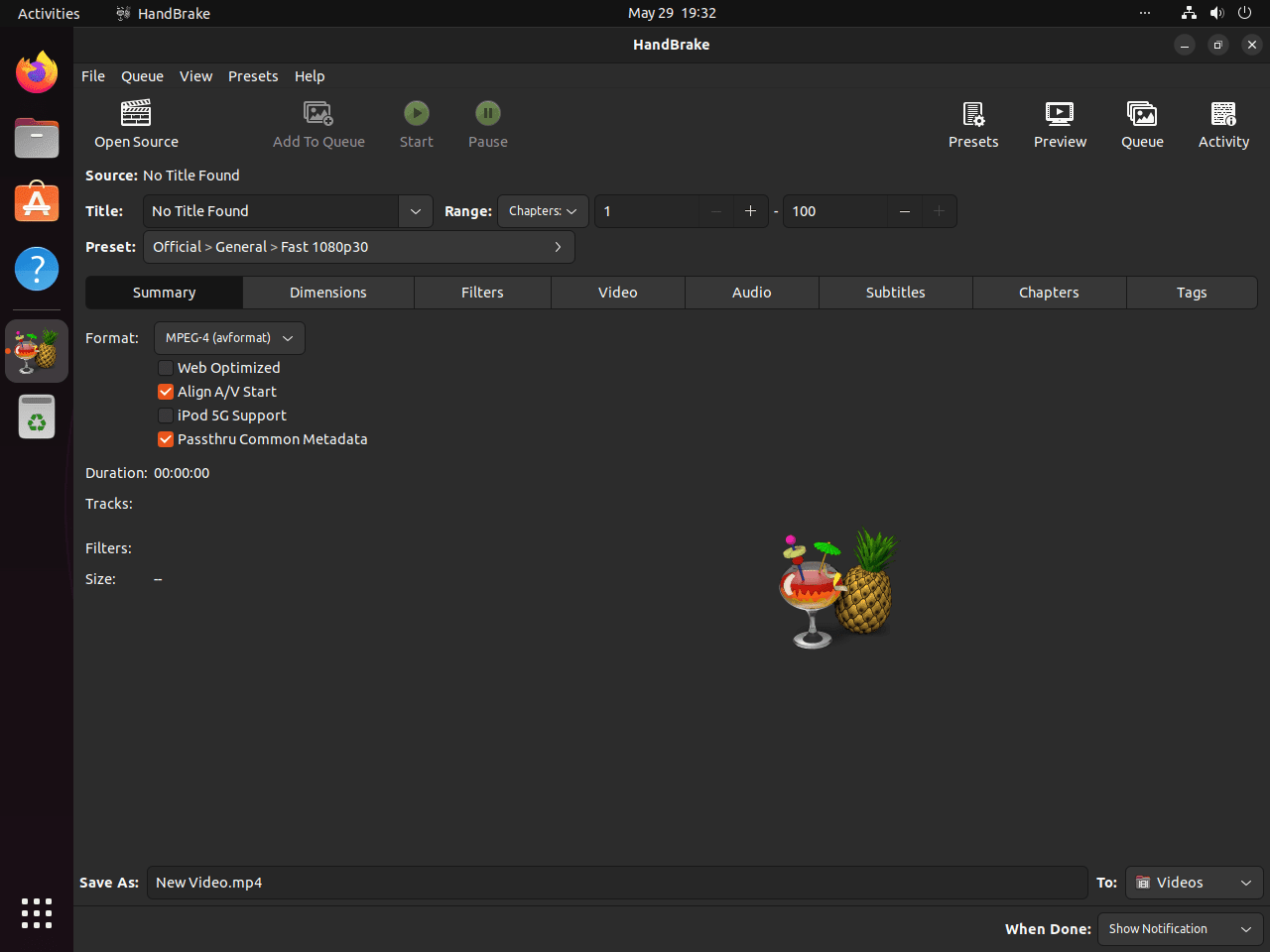HandBrake is a powerful open-source video transcoder that enables you to convert videos from nearly any format to a selection of modern, widely supported codecs. It offers an easy-to-use interface and a variety of features, including batch processing, customizable presets, and extensive video and audio parameter adjustments. Suitable for both beginners and advanced users, HandBrake is a reliable tool for video conversion and compression.
The following guide will demonstrate the steps to install HandBrake on Ubuntu 24.04, 22.04, and 20.04 LTS distributions using the command-line terminal. The installation methods involve the APT package manager with Ubuntu’s default repository or the alternative Flatpak with the Flathub repository.
Method 1: Install HandBrake via Ubuntu’s Default Repository
Update Your Ubuntu System Before HandBrake Installation
The initial step in the installation process involves updating your Ubuntu system. Keeping your system updated ensures that all existing software packages are current, which can help prevent potential conflicts when installing new software. We ensure that our system’s existing software runs the latest version, guaranteeing a smoother installation of HandBrake.
To update your Ubuntu system, you’ll need to use the following commands:
sudo apt update
sudo apt upgradeInstall HandBrake via APT Command
sudo apt install handbrakeFor a new version of HandBrake, consider using Flatpak, which the next section will demonstrate.
Method 2: Install HandBrake via Flatpak and Flathub
This section will explore an alternative method of installing HandBrake employing the Flatpak package manager. Flatpak, similar to Snap, is a universal package manager for Linux distributions. It bundles dependencies with applications, making applications more stable and secure as they run in isolated environments. Additionally, it provides access to a vast range of applications that may not be available in your distribution’s default repositories.
Note: If your system is yet to have Flatpak installed, consider referring to our detailed guide on “How to Install Flatpak on Ubuntu” for a step-by-step tutorial on installing the most recent supported version of Flatpak.
Enable Flathub for HandBrake
Before installing HandBrake via Flatpak, enabling the Flathub repository is crucial. Flathub is a primary hub for distributing applications on Flatpak and harboring various applications, HandBrake included.
You’ll employ the following command to add the Flathub repository to your Flatpak configuration. This action ensures broader access to numerous applications:
sudo flatpak remote-add --if-not-exists flathub https://flathub.org/repo/flathub.flatpakrepoUpon executing this command, the Flathub repository becomes integral to your Flatpak configuration, paving the way for installing HandBrake and many other applications.
Install HandBrake via Flatpak Command
With Flathub successfully enabled, you can install HandBrake using the flatpak install command. Execute the following command in your terminal:
flatpak install flathub fr.handbrake.ghb -yThis command fetches and installs HandBrake from the Flathub repository, equipping your system with the latest version of this powerful video transcoder.
Launch HandBrake via CLI or GUI
Now that HandBrake has been successfully installed using the APT or Flatpak method, it’s time to learn how to launch this powerful video transcoder.
Launching HandBrake from the Terminal
One method to launch HandBrake is directly from your terminal. This can be achieved by using a simple command:
handbrakeHowever, the command changes slightly if you have installed HandBrake using Flatpak. Flatpak applications require a unique application ID when launching from the terminal. To launch HandBrake installed via Flatpak, use the following command:
flatpak run fr.handbrake.ghbWhile this is certainly an effective way to launch HandBrake, it might not be the most practical, especially if you prefer using a graphical interface over the terminal.
Launching HandBrake from the Desktop Environment
A more user-friendly way to launch HandBrake involves utilizing Ubuntu’s desktop environment. Here is the path to launch HandBrake:
- Activities: Locate and click on the Activities button, usually located at the top left corner of your desktop. This will display all running applications and provide access to the application launcher.
- Show Applications: Find and click on the ‘Show Applications’ button, often symbolized by a grid of dots. This will reveal a list of all the installed applications on your Ubuntu system.
- HandBrake: Scroll through your applications or use the search bar to locate HandBrake. Click on the HandBrake icon to launch the application.


Managing HandBrake
Update HandBrake
HandBrake, like any other software, receives updates regularly. These updates often provide new features, performance improvements, and bug fixes, enhancing the overall user experience.
APT Update Method for HandBrake Installations
If you installed HandBrake using APT, use the following command to update:
sudo apt updateFlatpak Update Method for HandBrake Installations
For those who used Flatpak for installation, the following command will check for updates:
flatpak updateUninstall HandBrake
If you no longer need HandBrake, it can be uninstalled from your system. Again, the procedure varies based on the installation method you initially chose.
APT Removal Method for HandBrake Installations
If HandBrake was installed using APT, the following command will remove it from your system:
sudo apt remove handbrakeFlatpak Removal Method for HandBrake Installations
For HandBrake installations performed via Flatpak, use the below command for uninstallation:
flatpak remove --delete-data fr.handbrake.ghb -yConclusion
We’ve covered how to install HandBrake on Ubuntu 24.04, 22.04, and 20.04 LTS, simplifying your video transcoding tasks. HandBrake is a reliable tool for converting and editing videos, ideal for both batch processing and fine-tuning individual files. Try it out, explore its features, and see how it can enhance your video projects. Remember, the more you use it, the better you’ll get, so don’t hesitate to experiment with its various options.

